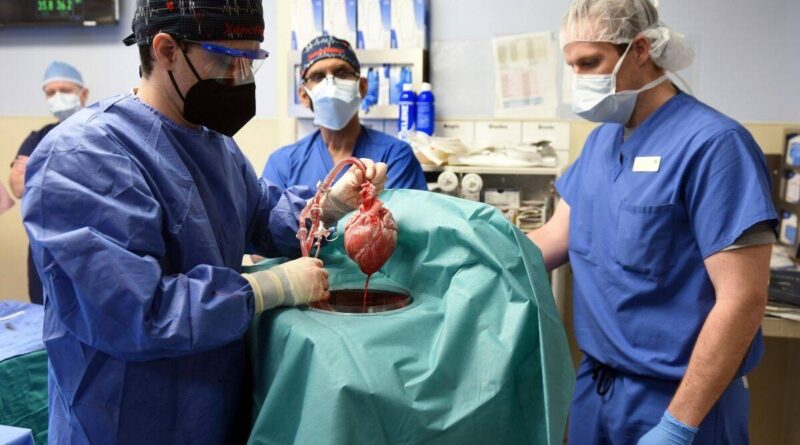Baltimore (US) In a medical first, croakers scattered a gormandizer heart into a case in a last- gutter trouble to save his life and a Maryland sanitarium said Monday that he is doing well three days after the largely experimental surgery.
While it’s too soon to know if the operation really will work, it marks a step in the decades-long hunt to one day use beast organs for life- saving transplants. Croakers at the University of Maryland Medical Center say the transplant showed that a heart from a genetically modified beast can serve in the mortal body without immediate rejection.
The case, David Bennett, a 57- time-old Maryland handyperson, knew there was no guarantee the trial would work but he was dying, ineligible for a mortal heart transplant and had no other option, his son told The Associated Press.
It was either die or do this transplant. I want to live. I know it’s a shot in the dark, but it’s my last choice, Bennett said a day before the surgery, according to a statement handed by the University of Maryland School of Medicine.
On Monday, Bennett was breathing on his own while still connected to a heart-lung machine to help his new heart. The coming many weeks will be critical as Bennett recovers from the surgery and croakers precisely cover how his heart is faring.
There is a huge deficit of mortal organs bestowed for transplant, driving scientists to try to figure out how to use beast organs rather. Last time, there were just over heart transplants in theU.S., a record number, according to the United Network for Organ Participating, which oversees the nation’s transplant system.
Still, there will be an endless force of these organs for cases who are suffering, said Dr,”If this works. Muhammad Mohiuddin, scientific director of the Maryland university’s beast-to-mortal transplant program.
But previous attempts at similar transplants or xenotransplantation have failed, largely because cases’ bodies fleetly rejected the beast organ. Specially, in 1984, Baby Fae, a dying child, lived 21 days with a baboon heart.
The difference this time The Maryland surgeons used a heart from a gormandizer that had experienced gene-editing to remove a sugar in its cells that is responsible for that hyperactive-fast organ rejection. Several biotech companies are developing gormandizer organs for mortal transplant; the bone used for Friday’s operation came from Revivicor, a attachment of United Rectifiers.
I suppose you can characterize it as a watershed event,Dr. David Klassen, UNOS’ principal medical officer, said of the Maryland transplant.
Still, Klassen advised that it’s only a first conditional step into exploring whether this time around, xenotransplantation might eventually work.
The Food and Drug Administration, which oversees similar trials, allowed the surgery under what is called a compassionate use exigency authorization, available when a case with a life- hanging condition has no other options.
It’ll be pivotal to partake the data gathered from this transplant before extending it to further cases, said Karen Maschke, a exploration scholar at the Hastings Center, who’s helping develop ethics and policy recommendations for the first clinical trials under a entitlement from the National Institutes of Health.
Rushing into beast-to-mortal transplants without this information would not be judicious, Maschke said.
Over the times, scientists have turned from primates to gormandizers, tinkering with their genes.
Just last September, experimenters in New York performed an trial suggesting these kinds of gormandizers might offer pledge for beast-to-mortal transplants. Croakers temporarily attached a gormandizer’s order to a departed mortal body and watched it begin to work.
The Maryland transplant takes their trial to the coming position, saidDr. Robert Montgomery, who led that work at NYU Langone Health.
This is a truly remarkable advance,”he said in a statement.”As a heart transplant philanthropist, myself with a inheritable heart complaint, I’m thrilled by this news and the stopgap it gives to my family and other cases who’ll ultimately be saved by this advance.
The surgery last Friday took seven hours at the Baltimore sanitarium.Dr. Bartley Griffith, who performed the surgery, said the case’s condition heart failure and an irregular twinkle made him ineligible for a mortal heart transplant or a heart pump.
Griffith had scattered gormandizer hearts into about 50 baboons over five times, before offering the option to Bennett.
We are learning a lot every day with this gentleman, Griffith said. And so far, we are happy with our decision to move forward. And he’s as well Big smile on his face moment.
Pig heart faucets also have been used successfully for decades in humans, and Bennett’s son said his father had entered one about a decade agone.
As for the heart transplant, He realizes the magnitude of what was done and he really realizes the significance of it, David BennettJr. said. He couldn’t live, or he could last a day, or he could last a couple of days. I mean, we are in the unknown at this point.
